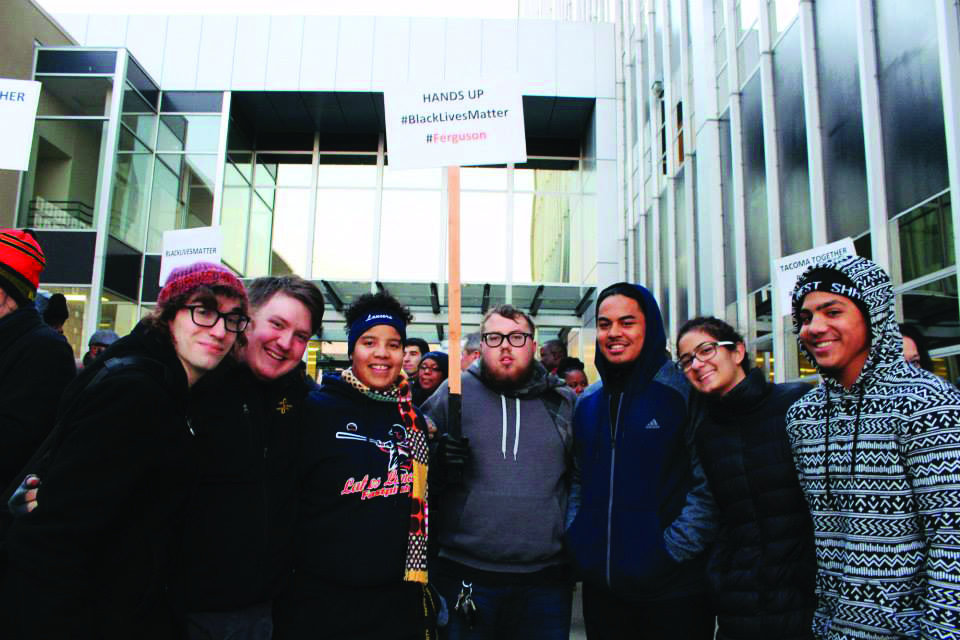Brennan LaBrie
Editor-In-Chief
In December, Pacific Lutheran University unveiled a campaign of promotional banners in public spaces in the area, from the Tacoma Mall to SeaTac Airport. One of these bright gold banners read: “PLU: Where you grow, but your tuition doesn’t.” This campaign promoted a new offer by the university to prospective students: a “fixed tuition guarantee.”
The guarantee ensures a fixed tuition price of $49,472 for students entering PLU in the 2022-23 school year, and a price ceiling of that amount for current students.
PLU hopes that this guarantee will attract prospective students who may be scared off by PLU’s ever-increasing sticker price, said Mike Frechette, Dean of Enrollment Management and Student Financial Services at PLU. The university also hopes it will deter current students from withdrawing due to yearly raises in tuition costs.
“I was just looking at our withdrawal forms from last year recently, and of the students who officially withdrew from the institution last year, 54 cited tuition and fees as one of the main reasons that they were leaving the institution,” he said. “So we’re hoping with a tuition guarantee that that number will shrink, and we’ll start to see our retention rates go up as well.”
The sticker price, Frechette noted, is the official full cost of tuition for PLU students, but is rarely paid in full due to the high amount of financial and merit offered by the university. According to PLU’s website, 98% of its students receive financial aid.
However, the annual tuition increase, which averages about $1,700 per year, affects almost all students and their families nonetheless. The university has aimed to alleviate this burden on families for some time now, Frechette said.
“We’ve really been for a while trying to think about ways we can disrupt the current pricing model, instead of just constantly raising tuition and then raising financial aid every year,” he said.
Why $49,472?
The school weighed several factors in reaching this number as a price ceiling on tuition. They knew that the price would have to be higher than the current number of $46,816 to account for inflation, increasing operating costs, and other factors. It couldn’t be too much higher, however.
“We were basically trying to find a balance between the number that would be sufficient enough to cover our budgetary needs, while not creating the perception that we were becoming totally out of reach by having a tuition increase that was so significant that it was going to scare away potential applicants either,” Frechette said.
There is no coincidence that this number falls just under $50,000. Over the past decade, PLU’s tuition costs rose from just under $31,000 to $46,816. The $50,000 mark, sitting just beyond the horizon, loomed large to some PLU leaders.
“There is a little bit of anxiety amongst some stakeholders about the $50,000 number,” Frechette said. “We don’t have any evidence from the market that families or students would turn away from PLU en masse if we all of a sudden exceeded $50,000 in tuition, but there definitely are some leaders at PLU who would like to stay under that number as long as we possibly can.”
Why a tuition fix over a tuition reset?
In September 2020, Seattle Pacific University (SPU) announced that they were slashing tuition by 25% for the 2021-22 school year, from almost $47,000 to around $35,000. This move was done to attract students who may be scared off by the high sticker price, even if it was only paid in full by less than 5% of students thanks to school, state, and federal financial aid. Two months later, Willamette University in Salem, Oregon, another small liberal arts school, announced that they were cutting tuition 20% — from $53,300 to $43,500 — for the same reason.
PLU “looked closely” at implementing a similar tuition reset, Frechette said. However, they decided against such a move, for several reasons.
“The thing about tuition resets that I don’t think everybody understands is that they’re also financial aid resets,” he said, noting that while SPU slashed their tuition, they also reduced their merit scholarship and financial aid packages.
“Their financial aid was reduced proportionally so that families do end up paying the same amount out of pocket, because SPU, like any other school, still needs the same amount of revenue year after year in order to operate in the way it has in the past,” Frechette said.
“When we thought about tuition resets, they seemed more like sales tactics to us, and more like a little bit of smoke and mirrors,” he continued. “And we wanted to avoid that. We really wanted to pass on some significant savings to families by doing something like this.”
Considering that tuition rises by about $1,700 each year, in four years every PLU student pays roughly $10,200 more in tuition than they signed up to pay in their first year, he said. By putting a cap on tuition increases, PLU would save students up to $10,000 without any decreases in financial or merit aid taking away from those savings.
Guaranteed Admission
Last school year, PLU declared a state of “financial exigency” (or financial crisis), which resulted in the termination of 36 full-time faculty positions and several majors, such as Nordic Studies, German, Classical Studies, and Anthropology, as part of the Faculty Joint Committee (FJC) process. The FJC Handbook accredited the crisis to “rising costs, decreasing revenue and a smaller pool of applicants,” the latter of which was due to nationwide demographic trends. The annual increases in tuition have historically been necessary due to these factors, as well as others such as inflation and rising costs of living, Frechette said. With all these factors in mind, how can PLU afford to place a cap on tuition?
PLU is hoping that this guarantee will attract enough new students to offset the lost tuition revenue it brings about. The university would need 60 additional students for this to happen, Frechette said.
PLU is also banking on the recruitment potential of another recently launched program, the automatic admission partnership program, to bring in these 60 new students. The program was piloted this school year by PLU with neighboring Bethel School District. It involves PLU admissions counselors working with Bethel guidance counselors to determine which students would be a good fit for PLU based on curriculum and GPA, among other factors. These students are then offered automatic admission at PLU, with no application needed other than filling out a short interest form. This program was launched to bring in more local students to PLU, and to increase the low college application rate of schools such as Bethel by breaking down barriers to college enrollment. Following in the footsteps of colleges across Washington, PLU will be expanding this partnership to districts statewide — from Tacoma to Yakima and Mount Vernon — by next year.
“It’s a way to serve the state of Washington, but it’s also a way to generate additional enrollment for PLU,” Frechette said of the program. “These automatic admission partnerships, plus the added complement of a fixed tuition guarantee, make us confident that we’ll be able to generate the enrollment that’s necessary to cover the cost of not doing tuition increases.”
For more information on the fixed tuition guarantee, visit https://www.plu.edu/admission/fixed-tuition/.


















